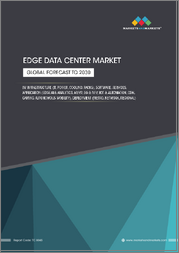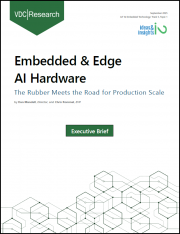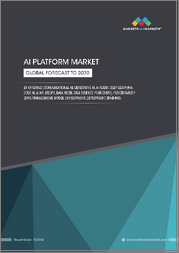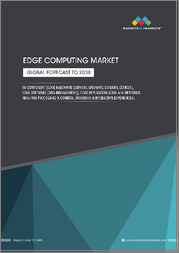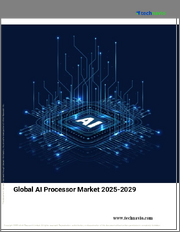
|
시장보고서
상품코드
1530686
세계의 엣지 AI 하드웨어 시장 전망(-2030년) : 프로세서 유형, 디바이스 유형, 배포, 용도, 지역별 분석Edge AI Hardware Market Forecasts to 2030 - Global Analysis By Processor Type (CPUs, GPUs, DSPs, NPUs, ASICs, FPGAs and Other Processor Types), Device Type, Deployment, Application and By Geography |
||||||
Stratistics MRC에 따르면, 세계 엣지 AI 하드웨어 시장은 2024년 256억 1,000만 달러에 이르고, 예측 기간 동안 18.7%의 연평균 복합 성장률(CAGR)로 성장하여 2030년에는 558억 2,000만 달러에 달할 것으로 예상됩니다.
엣지 AI 하드웨어는 중앙 집중식 클라우드 서버에 의존하지 않고 데이터 소스(엣지) 근처 또는 로컬에서 인공지능(AI) 작업을 수행하도록 설계된 특수 컴퓨팅 장치를 말합니다. 엣지 AI 하드웨어는 인터넷에 상시 연결하지 않고도 센서 및 기타 소스의 데이터를 실시간으로 처리할 수 있어 속도, 프라이버시, 대역폭 제약이 중요한 용도에 적합합니다.
CNN Business의 기사에 따르면, 한국 정부는 최첨단 반도체 칩에서 세계 최고의 지위를 유지하기 위한 노력의 일환으로 2027년까지 인공지능에 69억 4,000만 달러를 투자할 것이라고 합니다.
실시간 분석에 대한 수요 증가
엣지 AI 하드웨어는 디바이스가 로컬에서 복잡한 계산을 수행하여 대기 시간을 줄이고 데이터 인사이트에 대한 신속한 대응을 가능하게 합니다. 자율주행차, 제조, 헬스케어 등의 산업에서는 업무 효율성과 안전성을 위해 즉각적인 분석이 요구되고 있습니다. 엣지 AI 하드웨어를 도입하면 기업은 더 빠른 통찰력, 향상된 운영 민첩성, 향상된 응답성을 통해 중요한 용도의 실시간 분석에 대한 수요 증가에 대응할 수 있습니다.
확장성 문제
확장성 문제엣지 AI 하드웨어의 확장성 문제는 다양한 환경에 분산된 시스템을 배포하고 관리하는 복잡성에서 비롯됩니다. 이종 디바이스의 통합, 원활한 상호운용성 보장, 업데이트 및 유지보수 원격 관리 등의 과제가 있습니다. 또한, 증가하는 데이터 양과 진화하는 용도 요구사항에 대응하기 위해 엣지 AI 솔루션을 확장하려면 견고한 인프라와 숙련된 전문 지식이 필요합니다. 이러한 요소들은 도입 비용과 복잡성을 증가시키고, 확장성을 제한하며, 보급을 저해하는 요인으로 작용합니다.
IoT 디바이스의 급증
엣지 AI 하드웨어는 이러한 데이터를 로컬에서 처리하는 데 필수적이며, 지연시간과 대역폭 요구사항을 줄이고 실시간 의사결정 기능을 강화합니다. 이 기능은 스마트시티, 산업 자동화, 헬스케어 등 신속한 데이터 분석이 업무 효율성과 즉각적인 대응을 위해 필요한 용도에서 매우 중요하며, IoT 도입이 확대됨에 따라 엣지 AI 하드웨어가 제공하는 효율적이고 분산된 처리 솔루션에 대한 수요는 크게 증가할 것으로 예상됩니다. 수요가 크게 증가할 것으로 예상됩니다.
통합의 복잡성
엣지 AI 하드웨어 통합의 복잡성은 다양한 하드웨어 플랫폼, 소프트웨어 프레임워크, 기존 IT 인프라와의 호환성 문제로 인해 발생합니다. 이러한 복잡성은 도입 비용 증가, 전문적인 기술 전문 지식의 필요성, 솔루션 출시 시간 연장 가능성으로 인해 시장 성장을 저해하는 요인으로 작용합니다. 표준화된 프로토콜과 상호운용성 표준의 부재는 통합 작업을 더욱 복잡하게 만들고 서로 다른 엣지 컴퓨팅 환경 간의 확장성과 상호운용성을 제한하고 있습니다.
COVID-19의 영향
코로나19 팬데믹은 원격 근무, 의료 모니터링, 비대면 업무에서 분산형 데이터 처리의 필요성을 부각시키면서 엣지 AI 하드웨어의 채택을 가속화했습니다. 조직들은 실시간 데이터 분석을 보장하고 중앙 집중식 인프라에 대한 의존도를 최소화할 수 있는 솔루션을 찾았습니다. 이러한 변화는 특히 전 세계적으로 혼란이 발생했을 때 안전, 효율성, 연속성을 우선시하는 부문에서 엣지 AI 하드웨어에 대한 수요 증가를 이끌었습니다.
예측 기간 동안 서버 부문이 가장 큰 비중을 차지할 것으로 예상됩니다.
서버 부문은 유리한 성장세를 보일 것으로 추정됩니다. 엣지 AI 하드웨어에서 엣지 서버는 데이터 소스에 가까운 네트워크 주변부에 배치되는 특수 컴퓨팅 장치를 말합니다. 에지 서버는 AI 알고리즘의 로컬 처리를 용이하게 하고, 데이터 소스에 더 가까운 곳에서 데이터를 처리하여 대기 시간과 대역폭 소비를 줄입니다. 에지 서버는 IoT 배포 및 자율 시스템과 같이 실시간 분석이 필요한 용도에 매우 중요하며, 보다 빠른 의사 결정을 가능하게 하고 전체 시스템의 효율성과 응답성을 향상시킵니다.
예측 기간 동안 스마트시티 부문이 가장 높은 CAGR을 나타낼 것으로 예상됩니다.
스마트시티 분야는 예측 기간 동안 가장 높은 CAGR로 성장할 것으로 예상됩니다. 엣지 AI 하드웨어는 네트워크 엣지에서 실시간 데이터 처리 및 의사결정을 가능하게 함으로써 스마트시티에서 중요한 역할을 합니다. 이러한 장치는 도시 인프라의 효율적인 관리를 촉진합니다. 데이터를 로컬에서 처리함으로써 엣지 AI 하드웨어는 대기 시간을 줄이고, 자원 배분을 개선하고, 공공 안전을 강화하고, 서비스 제공을 최적화함으로써 스마트시티 구상의 발전과 지속가능성을 지원합니다.
가장 큰 점유율을 차지하는 지역
아태지역은 IoT 기기의 보급, 5G 인프라의 발전, 제조, 헬스케어, 자동차 등의 산업에서 AI 기반 용도의 채택이 증가함에 따라 예측 기간 동안 가장 큰 시장 점유율을 차지할 것으로 예상됩니다. 중국, 일본, 한국과 같은 국가들은 엣지 AI 솔루션의 혁신과 배포를 주도하고 있습니다. 이 지역의 역동적인 산업 환경과 디지털 전환을 촉진하는 정부 이니셔티브는 시장 확대를 더욱 촉진할 것으로 예상됩니다.
CAGR이 가장 높은 지역 :
북미는 특히 IoT, 자율 시스템, 스마트 제조 등의 기술 발전으로 인해 예측 기간 동안 가장 높은 CAGR을 보일 것으로 예상됩니다. 시장 확대를 이끄는 주요 요인으로는 스마트 시티 이니셔티브에 대한 투자 증가, 자율 주행 차량에 대한 수요 증가, 산업 자동화 및 헬스케어 분야의 커넥티드 디바이스 보급 등이 있습니다. 북미는 여전히 엣지 AI 하드웨어 기술의 발전과 채택을 촉진하는 매우 중요한 지역입니다.
무료 맞춤형 서비스 :
이 보고서를 구독하는 고객은 다음과 같은 무료 맞춤화 옵션 중 하나를 사용할 수 있습니다.
- 기업 프로파일
- 추가 시장 기업의 종합적인 프로파일링(최대 3개사까지)
- 주요 기업의 SWOT 분석(최대 3개사)
- 지역 세분화
- 고객의 관심에 따른 주요 국가별 시장 추정치, 예측, CAGR(주: 타당성 확인에 따라 다름)
- 경쟁사 벤치마킹
- 제품 포트폴리오, 지리적 입지, 전략적 제휴를 기반으로 한 주요 기업 벤치마킹
목차
제1장 주요 요약
제2장 서문
- 개요
- 이해관계자
- 조사 범위
- 조사 방법
- 데이터 마이닝
- 데이터 분석
- 데이터 검증
- 조사 접근
- 조사 정보원
- 1차 조사 정보원
- 2차 조사 정보원
- 전제조건
제3장 시장 동향 분석
- 성장 촉진요인
- 성장 억제요인
- 기회
- 위협
- 용도 분석
- 신흥 시장
- COVID-19의 영향
제4장 Porter의 Five Forces 분석
- 공급 기업의 교섭력
- 바이어의 교섭력
- 대체품의 위협
- 신규 진출업체의 위협
- 경쟁 기업간 경쟁 관계
제5장 세계의 엣지 AI 하드웨어 시장 : 프로세서 유형별
- CPU(중앙 처리장치)
- GPU(그래픽스 프로세싱 유닛)
- DSP(디지털 신호 프로세서)
- NPU(뉴럴 프로세싱 유닛)
- ASIC(주문형 집적회로)
- FPGA(필드 프로그래머블 게이트 어레이)
- 기타 프로세서 유형
제6장 세계의 엣지 AI 하드웨어 시장 : 디바이스 유형별
- 서버
- 게이트웨이
- 컴퓨팅 디바이스
- 카메라
- 로봇
- 드론
- 기타 디바이스 유형
제7장 세계의 엣지 AI 하드웨어 시장 : 전개 형태별
- 온프레미스
- 클라우드 엣지
- 포그 컴퓨팅
제8장 세계의 엣지 AI 하드웨어 시장 : 용도별
- 자율주행차
- 헬스케어
- 감시 및 보안
- 가전
- 소매
- 스마트 시티
- 기타 용도
제9장 세계의 엣지 AI 하드웨어 시장 : 지역별
- 북미
- 미국
- 캐나다
- 멕시코
- 유럽
- 독일
- 영국
- 이탈리아
- 프랑스
- 스페인
- 기타 유럽
- 아시아태평양
- 일본
- 중국
- 인도
- 호주
- 뉴질랜드
- 한국
- 기타 아시아태평양
- 남미
- 아르헨티나
- 브라질
- 칠레
- 기타 남미
- 중동 및 아프리카
- 사우디아라비아
- 아랍에미리트(UAE)
- 카타르
- 남아프리카공화국
- 기타 중동 및 아프리카
제10장 주요 발전
- 계약/파트너십/협업/합작투자(JV)
- 인수와 합병
- 신제품 발매
- 사업 확대
- 기타 주요 전략
제11장 기업 프로파일링
- NVIDIA
- Intel
- Qualcomm
- Google
- Synopsys
- CEVA Inc.
- Xilinx
- Huawei
- Samsung Electronics
- NXP Semiconductors
- Texas Instruments
- Apple
- Micron Technology
LSH 24.08.22
According to Stratistics MRC, the Global Edge AI Hardware Market is accounted for $25.61 billion in 2024 and is expected to reach $55.82 billion by 2030 growing at a CAGR of 18.7% during the forecast period. Edge AI hardware refers to specialized computing devices designed to perform artificial intelligence (AI) tasks locally, at or near the data source (the edge) rather than relying on centralized cloud servers. Edge AI hardware enables real-time processing of data from sensors and other sources without requiring constant internet connectivity, making it ideal for applications where speed, privacy, or bandwidth constraints are critical.
According to an article by CNN Business, the South Korean government will invest USD 6.94 billion in artificial intelligence by 2027 as part of efforts to retain a leading global position in cutting-edge semiconductor chips.
Market Dynamics:
Driver:
Increasing demand for real-time analytics
Edge AI hardware enables devices to perform complex computations locally, reducing latency and enabling quicker responses to data insights. Industries such as autonomous vehicles, manufacturing, and healthcare require instantaneous analytics for operational efficiency and safety. By deploying Edge AI hardware, organizations can achieve faster insights, improved operational agility, and enhanced responsiveness, thereby meeting the growing demand for real-time analytics in critical applications.
Restraint:
Scalability issues
Scalability issues in Edge AI hardware arise from complexities in deploying and managing distributed systems across diverse environments. Challenges include integrating heterogeneous devices, ensuring seamless interoperability, and managing updates and maintenance remotely. Furthermore, scaling edge AI solutions to accommodate growing data volumes and evolving application requirements requires robust infrastructure and skilled expertise. These factors increase deployment costs and complexity, limiting scalability and hindering widespread adoption.
Opportunity:
Proliferation of IoT devices
Edge AI hardware is essential for processing this data locally; reducing latency and bandwidth requirements while enhancing real-time decision-making capabilities. This capability is crucial in applications such as smart cities, industrial automation, and healthcare, where rapid data analysis is necessary for operational efficiency and responsiveness. As IoT deployments continue to expand, the demand for efficient, decentralized processing solutions provided by edge AI hardware is expected to rise significantly.
Threat:
Complexity in integration
Complexity in integrating Edge AI hardware arises due to diverse hardware platforms, software frameworks, and compatibility issues with existing IT infrastructures. This complexity hampers market growth by increasing deployment costs, requiring specialized technical expertise, and potentially extending time-to-market for solutions. Lack of standardized protocols and interoperability standards further complicates integration efforts, limiting scalability and interoperability across different edge computing environments.
Covid-19 Impact
The covid-19 pandemic accelerated the adoption of edge AI hardware by highlighting the need for decentralized data processing in remote work setups, healthcare monitoring, and contactless operations. Organizations sought solutions that could ensure real-time data analysis and minimize dependence on centralized infrastructure. This shift drove increased demand for edge AI hardware, particularly in sectors prioritizing safety, efficiency, and continuity during global disruptions.
The servers segment is expected to be the largest during the forecast period
The servers segment is estimated to have a lucrative growth. Edge servers in Edge AI hardware refer to specialized computing devices positioned at the periphery of networks, closer to data sources. They facilitate local processing of AI algorithms, reducing latency and bandwidth consumption by handling data closer to its origin. Edge servers are crucial for applications requiring real-time analytics, such as IoT deployments and autonomous systems, enabling faster decision-making and enhancing overall system efficiency and responsiveness.
The smart cities segment is expected to have the highest CAGR during the forecast period
The smart cities segment is anticipated to witness the highest CAGR growth during the forecast period. Edge AI hardware plays a crucial role in smart cities by enabling real-time data processing and decision-making at the edge of the network. These devices facilitate efficient management of urban infrastructure. By processing data locally, Edge AI hardware reduces latency, improves resource allocation, enhances public safety, and optimizes service delivery, thereby supporting the development and sustainability of smart city initiatives.
Region with largest share:
Asia Pacific is projected to hold the largest market share during the forecast period driven by the proliferation of IoT devices, advancements in 5G infrastructure, and increasing adoption of AI-driven applications across industries such as manufacturing, healthcare, and automotive. Countries like China, Japan, and South Korea are leading in technological innovation and deployment of edge AI solutions. The region's dynamic industrial landscape and government initiatives promoting digital transformation further bolster market expansion.
Region with highest CAGR:
North America is projected to have the highest CAGR over the forecast period driven by the region's technological advancements, particularly in IoT, autonomous systems, and smart manufacturing. Key factors propelling market expansion include increasing investments in smart city initiatives, rising demand for autonomous vehicles, and the proliferation of connected devices in industrial automation and healthcare sectors. North America remains a pivotal region for driving advancements and adoption of Edge AI hardware technologies.
Key players in the market
Some of the key players profiled in the Edge AI Hardware Market include NVIDIA, Intel, Qualcomm, Google, Synopsys, CEVA Inc., Xilinx, Huawei, Samsung Electronics, NXP Semiconductors, Texas Instruments, Apple and Micron Technology.
Key Developments:
In July 2024, Google launched distributed cloud edge hardware to run AI workloads in or outside its data centers. The Google Distributed Cloud (GDC) air-gapped appliance is mostly for highly regulated organizations that must keep data in-house. The hardware runs the Google Cloud infrastructure stack, data security services and Vertex AI platform. Vertex AI runs models that have been pretrained for various tasks.
In September 2022, NVIDIA introduced the NVIDIA IGX platform for high-precision edge AI, bringing advanced security and proactive safety to sensitive industries such as manufacturing, logistics and healthcare. NVIDIA IGX will help companies build the next generation of software-defined industrial and medical devices that can safely operate in the same environment as humans.
Processor Types Covered:
- CPUs (Central Processing Units)
- GPUs (Graphics Processing Units)
- DSPs (Digital Signal Processors)
- NPUs (Neural Processing Units)
- ASICs (Application-Specific Integrated Circuits)
- FPGAs (Field-Programmable Gate Arrays)
- Other Processor Types
Device Types Covered:
- Servers
- Gateways
- Computing Devices
- Cameras
- Robots
- Drones
- Other Device Types
Deployments Covered:
- On-Premises
- Cloud-Edge
- Fog Computing
Applications Covered:
- Autonomous Vehicles
- Healthcare
- Surveillance & Security
- Consumer Electronics
- Retail
- Smart Cities
- Other Applications
Regions Covered:
- North America
- US
- Canada
- Mexico
- Europe
- Germany
- UK
- Italy
- France
- Spain
- Rest of Europe
- Asia Pacific
- Japan
- China
- India
- Australia
- New Zealand
- South Korea
- Rest of Asia Pacific
- South America
- Argentina
- Brazil
- Chile
- Rest of South America
- Middle East & Africa
- Saudi Arabia
- UAE
- Qatar
- South Africa
- Rest of Middle East & Africa
What our report offers:
- Market share assessments for the regional and country-level segments
- Strategic recommendations for the new entrants
- Covers Market data for the years 2022, 2023, 2024, 2026, and 2030
- Market Trends (Drivers, Constraints, Opportunities, Threats, Challenges, Investment Opportunities, and recommendations)
- Strategic recommendations in key business segments based on the market estimations
- Competitive landscaping mapping the key common trends
- Company profiling with detailed strategies, financials, and recent developments
- Supply chain trends mapping the latest technological advancements
Free Customization Offerings:
All the customers of this report will be entitled to receive one of the following free customization options:
- Company Profiling
- Comprehensive profiling of additional market players (up to 3)
- SWOT Analysis of key players (up to 3)
- Regional Segmentation
- Market estimations, Forecasts and CAGR of any prominent country as per the client's interest (Note: Depends on feasibility check)
- Competitive Benchmarking
- Benchmarking of key players based on product portfolio, geographical presence, and strategic alliances
Table of Contents
1 Executive Summary
2 Preface
- 2.1 Abstract
- 2.2 Stake Holders
- 2.3 Research Scope
- 2.4 Research Methodology
- 2.4.1 Data Mining
- 2.4.2 Data Analysis
- 2.4.3 Data Validation
- 2.4.4 Research Approach
- 2.5 Research Sources
- 2.5.1 Primary Research Sources
- 2.5.2 Secondary Research Sources
- 2.5.3 Assumptions
3 Market Trend Analysis
- 3.1 Introduction
- 3.2 Drivers
- 3.3 Restraints
- 3.4 Opportunities
- 3.5 Threats
- 3.6 Application Analysis
- 3.7 Emerging Markets
- 3.8 Impact of Covid-19
4 Porters Five Force Analysis
- 4.1 Bargaining power of suppliers
- 4.2 Bargaining power of buyers
- 4.3 Threat of substitutes
- 4.4 Threat of new entrants
- 4.5 Competitive rivalry
5 Global Edge AI Hardware Market, By Processor Type
- 5.1 Introduction
- 5.2 CPUs (Central Processing Units)
- 5.3 GPUs (Graphics Processing Units)
- 5.4 DSPs (Digital Signal Processors)
- 5.5 NPUs (Neural Processing Units)
- 5.6 ASICs (Application-Specific Integrated Circuits)
- 5.7 FPGAs (Field-Programmable Gate Arrays)
- 5.8 Other Processor Types
6 Global Edge AI Hardware Market, By Device Type
- 6.1 Introduction
- 6.2 Servers
- 6.3 Gateways
- 6.4 Computing Devices
- 6.5 Cameras
- 6.6 Robots
- 6.7 Drones
- 6.8 Other Device Types
7 Global Edge AI Hardware Market, By Deployment
- 7.1 Introduction
- 7.2 On-Premises
- 7.3 Cloud-Edge
- 7.4 Fog Computing
8 Global Edge AI Hardware Market, By Application
- 8.1 Introduction
- 8.2 Autonomous Vehicles
- 8.3 Healthcare
- 8.4 Surveillance & Security
- 8.5 Consumer Electronics
- 8.6 Retail
- 8.7 Smart Cities
- 8.8 Other Applications
9 Global Edge AI Hardware Market, By Geography
- 9.1 Introduction
- 9.2 North America
- 9.2.1 US
- 9.2.2 Canada
- 9.2.3 Mexico
- 9.3 Europe
- 9.3.1 Germany
- 9.3.2 UK
- 9.3.3 Italy
- 9.3.4 France
- 9.3.5 Spain
- 9.3.6 Rest of Europe
- 9.4 Asia Pacific
- 9.4.1 Japan
- 9.4.2 China
- 9.4.3 India
- 9.4.4 Australia
- 9.4.5 New Zealand
- 9.4.6 South Korea
- 9.4.7 Rest of Asia Pacific
- 9.5 South America
- 9.5.1 Argentina
- 9.5.2 Brazil
- 9.5.3 Chile
- 9.5.4 Rest of South America
- 9.6 Middle East & Africa
- 9.6.1 Saudi Arabia
- 9.6.2 UAE
- 9.6.3 Qatar
- 9.6.4 South Africa
- 9.6.5 Rest of Middle East & Africa
10 Key Developments
- 10.1 Agreements, Partnerships, Collaborations and Joint Ventures
- 10.2 Acquisitions & Mergers
- 10.3 New Product Launch
- 10.4 Expansions
- 10.5 Other Key Strategies
11 Company Profiling
- 11.1 NVIDIA
- 11.2 Intel
- 11.3 Qualcomm
- 11.4 Google
- 11.5 Synopsys
- 11.6 CEVA Inc.
- 11.7 Xilinx
- 11.8 Huawei
- 11.9 Samsung Electronics
- 11.10 NXP Semiconductors
- 11.11 Texas Instruments
- 11.12 Apple
- 11.13 Micron Technology
- 추가 시장 기업의 종합적인 프로파일링(최대 3개사까지)
- 주요 기업의 SWOT 분석(최대 3개사)
- 고객의 관심에 따른 주요 국가별 시장 추정치, 예측, CAGR(주: 타당성 확인에 따라 다름)
- 제품 포트폴리오, 지리적 입지, 전략적 제휴를 기반으로 한 주요 기업 벤치마킹
- 데이터 마이닝
- 데이터 분석
- 데이터 검증
- 조사 접근
- 1차 조사 정보원
- 2차 조사 정보원
- 전제조건
- 미국
- 캐나다
- 멕시코
- 독일
- 영국
- 이탈리아
- 프랑스
- 스페인
- 기타 유럽
- 일본
- 중국
- 인도
- 호주
- 뉴질랜드
- 한국
- 기타 아시아태평양
- 아르헨티나
- 브라질
- 칠레
- 기타 남미
- 사우디아라비아
- 아랍에미리트(UAE)
- 카타르
- 남아프리카공화국
- 기타 중동 및 아프리카
According to Stratistics MRC, the Global Edge AI Hardware Market is accounted for $25.61 billion in 2024 and is expected to reach $55.82 billion by 2030 growing at a CAGR of 18.7% during the forecast period. Edge AI hardware refers to specialized computing devices designed to perform artificial intelligence (AI) tasks locally, at or near the data source (the edge) rather than relying on centralized cloud servers. Edge AI hardware enables real-time processing of data from sensors and other sources without requiring constant internet connectivity, making it ideal for applications where speed, privacy, or bandwidth constraints are critical.
According to an article by CNN Business, the South Korean government will invest USD 6.94 billion in artificial intelligence by 2027 as part of efforts to retain a leading global position in cutting-edge semiconductor chips.
Market Dynamics:
Driver:
Increasing demand for real-time analytics
Edge AI hardware enables devices to perform complex computations locally, reducing latency and enabling quicker responses to data insights. Industries such as autonomous vehicles, manufacturing, and healthcare require instantaneous analytics for operational efficiency and safety. By deploying Edge AI hardware, organizations can achieve faster insights, improved operational agility, and enhanced responsiveness, thereby meeting the growing demand for real-time analytics in critical applications.
Restraint:
Scalability issues
Scalability issues in Edge AI hardware arise from complexities in deploying and managing distributed systems across diverse environments. Challenges include integrating heterogeneous devices, ensuring seamless interoperability, and managing updates and maintenance remotely. Furthermore, scaling edge AI solutions to accommodate growing data volumes and evolving application requirements requires robust infrastructure and skilled expertise. These factors increase deployment costs and complexity, limiting scalability and hindering widespread adoption.
Opportunity:
Proliferation of IoT devices
Edge AI hardware is essential for processing this data locally; reducing latency and bandwidth requirements while enhancing real-time decision-making capabilities. This capability is crucial in applications such as smart cities, industrial automation, and healthcare, where rapid data analysis is necessary for operational efficiency and responsiveness. As IoT deployments continue to expand, the demand for efficient, decentralized processing solutions provided by edge AI hardware is expected to rise significantly.
Threat:
Complexity in integration
Complexity in integrating Edge AI hardware arises due to diverse hardware platforms, software frameworks, and compatibility issues with existing IT infrastructures. This complexity hampers market growth by increasing deployment costs, requiring specialized technical expertise, and potentially extending time-to-market for solutions. Lack of standardized protocols and interoperability standards further complicates integration efforts, limiting scalability and interoperability across different edge computing environments.
Covid-19 Impact
The covid-19 pandemic accelerated the adoption of edge AI hardware by highlighting the need for decentralized data processing in remote work setups, healthcare monitoring, and contactless operations. Organizations sought solutions that could ensure real-time data analysis and minimize dependence on centralized infrastructure. This shift drove increased demand for edge AI hardware, particularly in sectors prioritizing safety, efficiency, and continuity during global disruptions.
The servers segment is expected to be the largest during the forecast period
The servers segment is estimated to have a lucrative growth. Edge servers in Edge AI hardware refer to specialized computing devices positioned at the periphery of networks, closer to data sources. They facilitate local processing of AI algorithms, reducing latency and bandwidth consumption by handling data closer to its origin. Edge servers are crucial for applications requiring real-time analytics, such as IoT deployments and autonomous systems, enabling faster decision-making and enhancing overall system efficiency and responsiveness.
The smart cities segment is expected to have the highest CAGR during the forecast period
The smart cities segment is anticipated to witness the highest CAGR growth during the forecast period. Edge AI hardware plays a crucial role in smart cities by enabling real-time data processing and decision-making at the edge of the network. These devices facilitate efficient management of urban infrastructure. By processing data locally, Edge AI hardware reduces latency, improves resource allocation, enhances public safety, and optimizes service delivery, thereby supporting the development and sustainability of smart city initiatives.
Region with largest share:
Asia Pacific is projected to hold the largest market share during the forecast period driven by the proliferation of IoT devices, advancements in 5G infrastructure, and increasing adoption of AI-driven applications across industries such as manufacturing, healthcare, and automotive. Countries like China, Japan, and South Korea are leading in technological innovation and deployment of edge AI solutions. The region's dynamic industrial landscape and government initiatives promoting digital transformation further bolster market expansion.
Region with highest CAGR:
North America is projected to have the highest CAGR over the forecast period driven by the region's technological advancements, particularly in IoT, autonomous systems, and smart manufacturing. Key factors propelling market expansion include increasing investments in smart city initiatives, rising demand for autonomous vehicles, and the proliferation of connected devices in industrial automation and healthcare sectors. North America remains a pivotal region for driving advancements and adoption of Edge AI hardware technologies.
Key players in the market
Some of the key players profiled in the Edge AI Hardware Market include NVIDIA, Intel, Qualcomm, Google, Synopsys, CEVA Inc., Xilinx, Huawei, Samsung Electronics, NXP Semiconductors, Texas Instruments, Apple and Micron Technology.
Key Developments:
In July 2024, Google launched distributed cloud edge hardware to run AI workloads in or outside its data centers. The Google Distributed Cloud (GDC) air-gapped appliance is mostly for highly regulated organizations that must keep data in-house. The hardware runs the Google Cloud infrastructure stack, data security services and Vertex AI platform. Vertex AI runs models that have been pretrained for various tasks.
In September 2022, NVIDIA introduced the NVIDIA IGX platform for high-precision edge AI, bringing advanced security and proactive safety to sensitive industries such as manufacturing, logistics and healthcare. NVIDIA IGX will help companies build the next generation of software-defined industrial and medical devices that can safely operate in the same environment as humans.
Processor Types Covered:
- CPUs (Central Processing Units)
- GPUs (Graphics Processing Units)
- DSPs (Digital Signal Processors)
- NPUs (Neural Processing Units)
- ASICs (Application-Specific Integrated Circuits)
- FPGAs (Field-Programmable Gate Arrays)
- Other Processor Types
Device Types Covered:
- Servers
- Gateways
- Computing Devices
- Cameras
- Robots
- Drones
- Other Device Types
Deployments Covered:
- On-Premises
- Cloud-Edge
- Fog Computing
Applications Covered:
- Autonomous Vehicles
- Healthcare
- Surveillance & Security
- Consumer Electronics
- Retail
- Smart Cities
- Other Applications
Regions Covered:
- North America
- US
- Canada
- Mexico
- Europe
- Germany
- UK
- Italy
- France
- Spain
- Rest of Europe
- Asia Pacific
- Japan
- China
- India
- Australia
- New Zealand
- South Korea
- Rest of Asia Pacific
- South America
- Argentina
- Brazil
- Chile
- Rest of South America
- Middle East & Africa
- Saudi Arabia
- UAE
- Qatar
- South Africa
- Rest of Middle East & Africa
What our report offers:
- Market share assessments for the regional and country-level segments
- Strategic recommendations for the new entrants
- Covers Market data for the years 2022, 2023, 2024, 2026, and 2030
- Market Trends (Drivers, Constraints, Opportunities, Threats, Challenges, Investment Opportunities, and recommendations)
- Strategic recommendations in key business segments based on the market estimations
- Competitive landscaping mapping the key common trends
- Company profiling with detailed strategies, financials, and recent developments
- Supply chain trends mapping the latest technological advancements
Free Customization Offerings:
All the customers of this report will be entitled to receive one of the following free customization options:
- Company Profiling
- Comprehensive profiling of additional market players (up to 3)
- SWOT Analysis of key players (up to 3)
- Regional Segmentation
- Market estimations, Forecasts and CAGR of any prominent country as per the client's interest (Note: Depends on feasibility check)
- Competitive Benchmarking
- Benchmarking of key players based on product portfolio, geographical presence, and strategic alliances
Table of Contents
1 Executive Summary
2 Preface
- 2.1 Abstract
- 2.2 Stake Holders
- 2.3 Research Scope
- 2.4 Research Methodology
- 2.4.1 Data Mining
- 2.4.2 Data Analysis
- 2.4.3 Data Validation
- 2.4.4 Research Approach
- 2.5 Research Sources
- 2.5.1 Primary Research Sources
- 2.5.2 Secondary Research Sources
- 2.5.3 Assumptions
3 Market Trend Analysis
- 3.1 Introduction
- 3.2 Drivers
- 3.3 Restraints
- 3.4 Opportunities
- 3.5 Threats
- 3.6 Application Analysis
- 3.7 Emerging Markets
- 3.8 Impact of Covid-19
4 Porters Five Force Analysis
- 4.1 Bargaining power of suppliers
- 4.2 Bargaining power of buyers
- 4.3 Threat of substitutes
- 4.4 Threat of new entrants
- 4.5 Competitive rivalry
5 Global Edge AI Hardware Market, By Processor Type
- 5.1 Introduction
- 5.2 CPUs (Central Processing Units)
- 5.3 GPUs (Graphics Processing Units)
- 5.4 DSPs (Digital Signal Processors)
- 5.5 NPUs (Neural Processing Units)
- 5.6 ASICs (Application-Specific Integrated Circuits)
- 5.7 FPGAs (Field-Programmable Gate Arrays)
- 5.8 Other Processor Types
6 Global Edge AI Hardware Market, By Device Type
- 6.1 Introduction
- 6.2 Servers
- 6.3 Gateways
- 6.4 Computing Devices
- 6.5 Cameras
- 6.6 Robots
- 6.7 Drones
- 6.8 Other Device Types
7 Global Edge AI Hardware Market, By Deployment
- 7.1 Introduction
- 7.2 On-Premises
- 7.3 Cloud-Edge
- 7.4 Fog Computing
8 Global Edge AI Hardware Market, By Application
- 8.1 Introduction
- 8.2 Autonomous Vehicles
- 8.3 Healthcare
- 8.4 Surveillance & Security
- 8.5 Consumer Electronics
- 8.6 Retail
- 8.7 Smart Cities
- 8.8 Other Applications
9 Global Edge AI Hardware Market, By Geography
- 9.1 Introduction
- 9.2 North America
- 9.2.1 US
- 9.2.2 Canada
- 9.2.3 Mexico
- 9.3 Europe
- 9.3.1 Germany
- 9.3.2 UK
- 9.3.3 Italy
- 9.3.4 France
- 9.3.5 Spain
- 9.3.6 Rest of Europe
- 9.4 Asia Pacific
- 9.4.1 Japan
- 9.4.2 China
- 9.4.3 India
- 9.4.4 Australia
- 9.4.5 New Zealand
- 9.4.6 South Korea
- 9.4.7 Rest of Asia Pacific
- 9.5 South America
- 9.5.1 Argentina
- 9.5.2 Brazil
- 9.5.3 Chile
- 9.5.4 Rest of South America
- 9.6 Middle East & Africa
- 9.6.1 Saudi Arabia
- 9.6.2 UAE
- 9.6.3 Qatar
- 9.6.4 South Africa
- 9.6.5 Rest of Middle East & Africa
10 Key Developments
- 10.1 Agreements, Partnerships, Collaborations and Joint Ventures
- 10.2 Acquisitions & Mergers
- 10.3 New Product Launch
- 10.4 Expansions
- 10.5 Other Key Strategies
11 Company Profiling
- 11.1 NVIDIA
- 11.2 Intel
- 11.3 Qualcomm
- 11.4 Google
- 11.5 Synopsys
- 11.6 CEVA Inc.
- 11.7 Xilinx
- 11.8 Huawei
- 11.9 Samsung Electronics
- 11.10 NXP Semiconductors
- 11.11 Texas Instruments
- 11.12 Apple
- 11.13 Micron Technology






